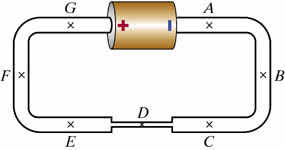PH 102 Lecture Notes - Lecture 7: Valence And Conduction Bands, Drift Velocity, Electric Field
Document Summary
Specifically, it is the charge per unit time that flows through a given cross-sectional area. (e. g. , the cross section of a wire). The accepted convention for the direction of current flow is the direction of the flow of positive charge. In a metal, however, current consists of electron flow, so that the current direction is opposite to the flow of electrons. In electrostatics the electric field inside a metal is zero, the electric potential is constant, and the charges are at rest. If a metal carries a current, then the electric field is not zero and the potential is not constant. This could happen, for example, by connecting the ends of a wire across the terminals of a battery. In a conductor the conduction electrons travel in zig-zag paths as they collide with atoms. The average distance between collisions is typically tens of nanometers.






